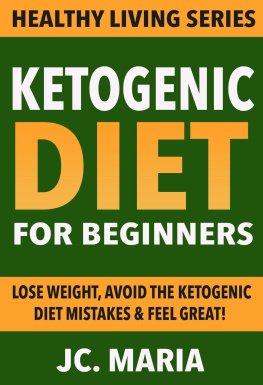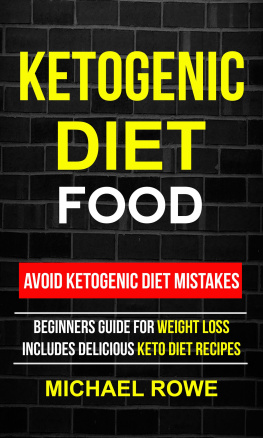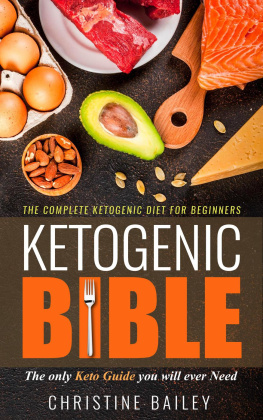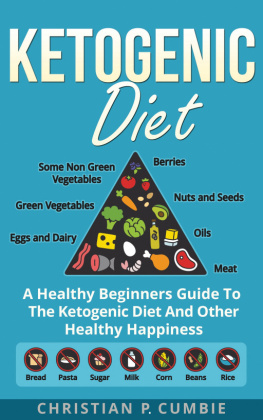Ketogenic Diet for Beginners: Lose Weight, Avoid the Ketogenic Diet Mistakes & Feel Great! (Healthy Living Series)
C opyright 2016 by JC. Maria
All rights reserved. No part of this book may be reproduced in any form or by any electronic or mechanical means, including information storage and retrieval systems except in the case of brief quotations in articles or reviews without the permission in writing from its publisher, JC. Maria .
All brand names and product names used in this book are trademarks, registered trademarks, or trade names of their respective holders. I am not associated with any product or vendor in this book.
Published By JC. Maria
Table Of Contents
Contents
About The Author
H i, my name is JC. Maria. I'm an author and a mommy with a little boy. I love travel, reading, writing and blogging. Welcome to my world at http://www.bestmommyblog.com and hope you enjoy my blog and my books.
Questions or comments? E-mail me at jcmariablogger@gmail.com or find me on the following social networks:
Google+: https://plus.google.com/u/1/102662299713872046282/posts
Twitter: https://twitter.com/jcmariablogger
Website: http://www.bestmommyblog.com
Chapter 1: What is the Ketogenic Diet? And How to Get Started
A ketogenic diet is also commonly known as the diet that consists low carbs (carbohydrates). In this diet, ketones are produced in the liver by the human body, which works in providing energy to other organ systems. Glucose and insulin are the two most common productions by the body whenever a meal is taken, which contains a high amount of carbs. Glucose is the only molecule which helps in providing energy to the body on the primary stage, whereas, insulin helps in transferring the glucose to other body parts by processing it in the blood flow.
When the body gets a lower supply of carbohydrates, it is induced in the state called Ketosis. Ketosis is a process in which a human is able to survive with the help of its own body due to low intake of carbs. By the help of this procedure, fat is broken down within the liver and Ketones are produced.
The Ketogenic diet helps in the production of ketone bodies through the liver, which helps in utilizing fat as the form of energy, instead of carbohydrates by transporting the metabolism of the body apart from glucose. The rule of ketogenic diet includes a certain amount of carbohydrates in a day (normally 100 grams in 24 hours). Proteins and fats can be included in the diet, but it all depends on the dieter and their goals.
The Metabolism and the Ketogenic Diet
Normally, the human body needs fats, proteins, and carbohydrates to run. On excluding carbohydrates from the diet, the small stores of the body are exhausted and therefore, the body begins to find substitute fuel that can provide energy to it. Other fuel includes the free fatty acids (FFA) and it is utilized by the major tissues of the body, but the FFA is not acceptable by all the organs. For example, nervous system and brain are not able to get energy from FFA, but ketone bodies are the real source of their fuel.
Ketone bodies play an important role in being a fat derived, non-carbohydrate fuel resource by providing energy to the brain like tissues, and they are the secondary product of the partial FFA breakdown in the liver. At accelerated rates, when ketone bodies are produced, it takes the body into the state of ketosis, as the ketone bodies get involved with the bloodstream. When the body goes into the process of ketosis, there is a decrease in the protein breakdown, utilized for energy, also known as protein sparing and glucose utilization, simultaneously. This is why most of the people, who are interested in losing body fat are involved in the ketogenic diet.
Hormones and the Ketogenic Diet
Ketogenic diet has a direct effect on the level of two important hormones, first is insulin and second is glucagon. On studying the nature of insulin, it is found that insulin is a type of hormone, which is responsible for transporting nutrients to the targeted tissues, by separating the nutrients from the bloodstream. For example, muscle stores glucose, which becomes glycogen and adipose tissue stores FFA which becomes triglycerides and this is all due to the insulin. The fuel-mobilizing hormone of the body is called the glucagon. This hormone breaks down the stored glycogen by stimulating the body for the supply of glucose to the overall body.
The level of glucagon increases and the level of insulin decreases when the diet contains no amount of carbohydrates. This even causes increased level of FFA, taken from the fat cells and the burning of FFA in the liver and this burning takes the body to the state of ketosis because it produces ketone bodies. Apart from glucagon and insulin, there are few other hormones, which also help in shifting the use of the fuel to fat and not by the carbohydrates.
Exercise and the Ketogenic Diet
The human body is made up of almost 600 muscles, including the large muscles, which are the quadratic muscles all the way to the small muscles that control the eye movement. The production of force completely depends on the ability of contraction and movement of these muscles within the body. Every exercise involved with the ketogenic diet depends on the production of the force and strength of these muscles, which makes necessary to understand some basic information about the force production, muscular physiology, and energy production.
Types of Muscle Fiber
Types of muscle fibers found in a human body are three and each type of muscles has its own properties and characteristics. It is important to know the difference between all types of muscle fibers because they are involved in the exercises and also it is essential to understand the types of fuels used.
The human skeleton system contains three types of muscle fibers.
- Slow oxidative (SO) or Type I
- Fast oxidative glycolytic (FOG) or Type IIa
- Fast glycolytic (FG) or Type IIb
Every type of fiber has its own physiological and physical characteristics (preferred fuel) which allow understanding the best and the most suitable activity for each of them, depending completely on the exercise type to adapt, so that there is an effect on the muscle fibers.
Overview of Muscle Fiber Types
Type I muscle fibers are the endurance or the patience fibers. They are not able to generate maximum force and fatigue slowly by utilizing predominantly fatty acids (FFA) as a fuel. Type I fibers are red colored fibers, and that is why they are also known as the red fibers, and they have a minimum capacity of growing muscles.
Type IIa fibers are the transitional fibers. Their force capacity is medium and contains fatigue attribute. Type IIa muscles are able to gain energy from glycogen or from any other type of activity which includes fat. They are pinkish in color and having the capacity to grow muscles between Type IIb and Type I fibers.
Type IIb are the fibers with high force, as they are able to generate the maximum level of force, but they fatigue soon. As a byproduct of IIb fibers, they are able to produce lactic acid by using glycogen as their main source of fuel. Type IIb fibers are used for, maximum force, high intensity, and activities of short duration, such as sprinting exercise and weight training. This type of fiber has a significant volume for growth, and they are white in color.
Some people consist Type I and Type IIb fibers in their body, but in equal number. Although, fibers are not able to change their type, their characteristics can be shifted to more anaerobic and aerobic exercises.
Exercise Overview
Exercise is divided into two main classifications: aerobic and anaerobic. Aerobic and Anaerobic exercises are quite different from each other in terms of duration, intensity and the production of energy. Aerobic exercise includes all the exercises which require oxygen and anaerobic exercises requires the ways in which no oxygen is required.













